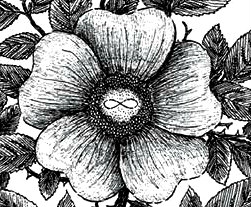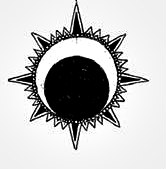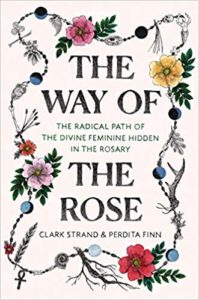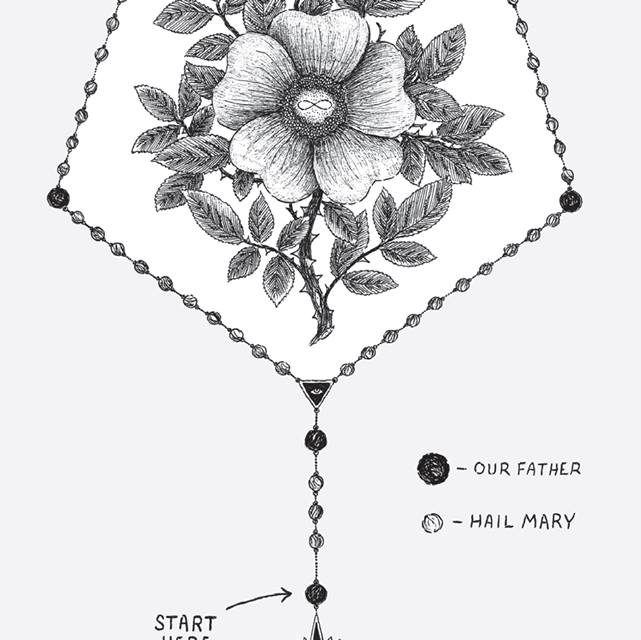The rosary? Really?
Why would I pray the rosary?
Why does Our Lady, in apparition after apparition, invite people to pray the rosary? Why in Medjugorgia did she say that you didn’t need to be Catholic, but you probably should pray the rosary?
Why did she say the same thing to my husband and me, an ex-Buddhist monk and his feminist wife?
Let’s just be clear here…I’m not Catholic, I’m not going to become Catholic and I’m not a fan of organized religions of any variety. (“No priests, no property” is my motto.) But I am devoted to the rosary and I want to share how powerful and healing it can be to hold these beads in your hand, to hold Her hand.
The Hail Mary comes to us from our ancestral grandmothers and is a hidden prayer to the triple goddess. They hid their lore in plain site. But we have to excavate all of this from patriarchial violence.
At its most simple the rosary teaches us to live in the long story again, the long story of our souls, instead of the little straight line of a single life. That’s not an idea. We learn it with our hands and with our hearts as we pray, and we find ourselves again standing in the circle of the world.
Those beads are our umbilical cord back to her. Does the umbilical cord belong to the mother or the child? It nourishes us, connects us, vitalizes us.

The Once And Future Queen
There are two creation stories for the rosary, one of which seems plausible, the other a little far-fetched. But in this case the less likely story turns out to be the true one. See if you can tell which is which.
The First Story
In the year 1209 St. Dominic was on a mission to convert the Cathars, a supposedly-heretical Christian sect that had become popular in the Languedoc region of Southern France and subsequently spread throughout Europe. When his mission ended in failure, Dominic retreated to the woods near Toulouse where he prayed and fasted in a cave.
After several days, the Virgin Mary appeared. She fed Dominic milk from Her breast to restore his strength and then told him that his method of conversion was the wrong one to use with the Cathars. Rather than the “battering ram” of fiery sermons, he should use the gentler method of Her “Angelic Psalter” (the rosary), which She then taught him how to pray. Dominic did so and the Cathars, who had previously resisted all efforts to bring them back into the Catholic fold, were converted through the rosary.
The Second Story
Once there was a good and simple lad who observed the custom of weaving a crown of flowers each day for the Virgin in his village church – of roses, or rue, or whatever was then in flower. When he joined religious orders, however, he was no longer permitted to observe this daily devotion. So great was his distress at this that he resolved to leave the order.
As he was about to depart from the cloister, however, the Virgin herself appeared. “Do not be dejected or downcast because you are no longer permitted to weave a crown of flowers for my head,” She said. “For I will teach you to make a crown of your prayers. These will be available in any season and are better for your soul.”
The young man “began forthwith to recite the rosary as he had been instructed by the Blessed Virgin when, behold! As each Ave Maria emerged from his mouth, it became a rose!” These the Virgin removed one by one from between his lips, weaving them into a beautiful crown of roses for Her head.
 Only one version of Dominic’s story exists (the written account of the Dominican friar Alanus de Rupe) although the part about the breast milk is virtually always suppressed in modern retellings. By contrast, many versions of the second story exist in the oral tradition from the same period.
Only one version of Dominic’s story exists (the written account of the Dominican friar Alanus de Rupe) although the part about the breast milk is virtually always suppressed in modern retellings. By contrast, many versions of the second story exist in the oral tradition from the same period.
Because there is an original, definitive version of the first tale (and because it refers to a historical person, place, and time) most people assume this one to be the story that contains the most truth. The second story seems more unreliable because it is a folk tale, each version of which preserves only the basic plot line of substituting flowers with prayers, which then miraculously become flowers again. In reality, however, this is the more historically accurate tale.
Dominic never owned a rosary: he lived over two centuries before the beads came into common use. And he failed utterly to convert the Cathars: they were exterminated by the Catholic Church a few years later in a campaign so ruthless and well-organized that Hitler used it as his model for the holocaust. In one day alone, 20,000 men, women, and children were slaughtered with the blessings of the ironically-named Pope Innocent III. Not only is there no truth whatsoever to the church’s official version of how the rosary came to be, it’s nothing more than a cover-up – a story told to prevent anyone from asking what really happened to the Cathars.
By contrast, the folk story is actually pretty reliable. Believe what you will about the miracle of the roses and whether it actually happened, the fact remains that the beads gave people across Europe a way to continue their worship of the Goddess through seasonal/Earth-based rituals like the rosary which they transferred directly to the Virgin Mary.
Remember that in the second story flowers become prayers, which become flowers once again. The movement here is from Earth to Sky, then back to Earth again. It is an encoded prophecy to the faithful, hidden in plain sight of the church fathers, that said, “We lost the Goddess once, but we will get Her back again – Our Once and Future Queen.”
Illustrations by Will Lytle. Find out more at wayoftherose.org

Perdita Finn’s upcoming book reveals what happens when a former Zen Buddhist monk and a feminist writer experience an apparition of the Virgin Mary.







Thank you. Your words and the rosary story have given my aching heart ease. Blessed be Mary full of grace.
I appreciated the various parallels you drew and the interesting illustrative tales. Perhaps you also know that the rosary within the Catholic tradition may have its origins in the Buddhist prayer practice which uses prayer beads It wou;d be interesting to discover these connections. Thanks for an illuminating article.